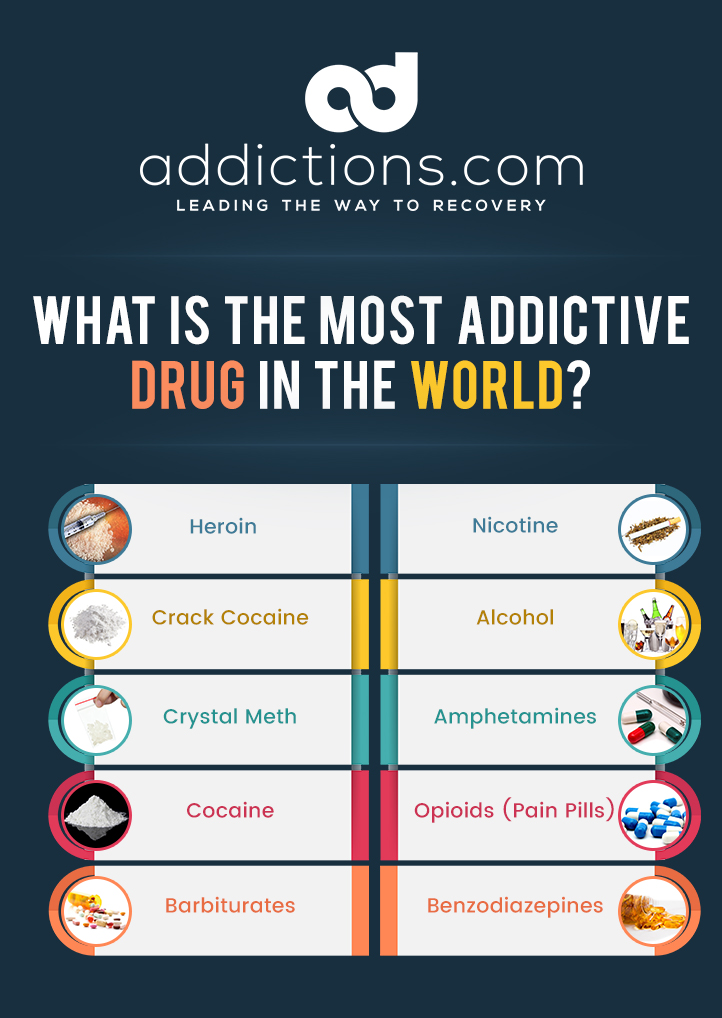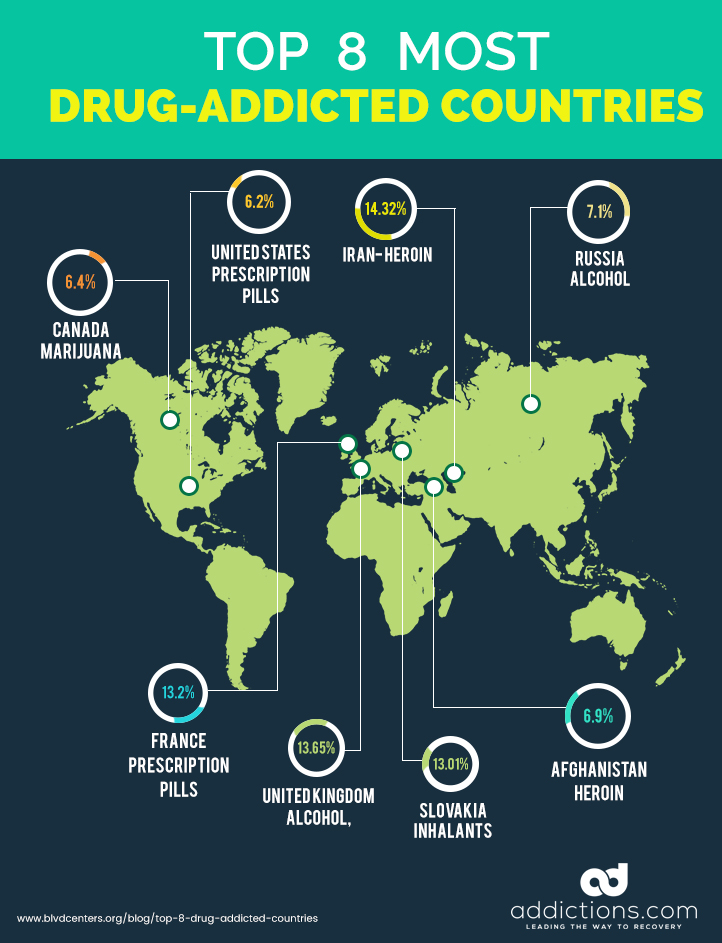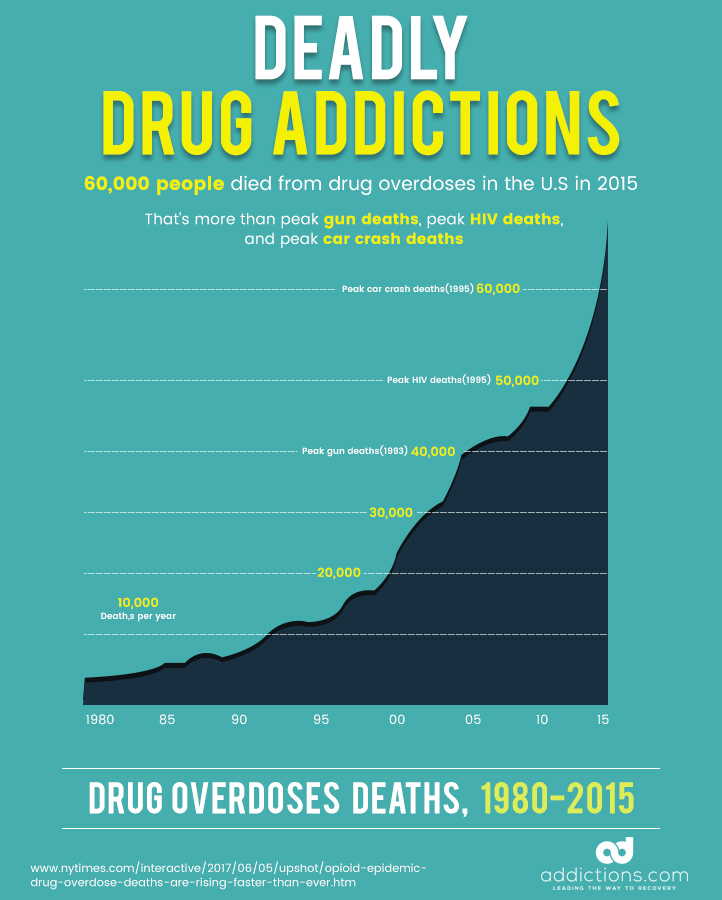Many of the most highly addictive drugs in the world are prescribed to you by your family doctor, and can be found in the average person’s medicine cabinet. Some addictive drugs are sold at most neighborhood corner stores, while others can be purchased on the street for extremely low costs. Addictive drugs and substances are usually easily accessible and can be found nearly everywhere, which is why substance abuse has become a major public health crisis in the U.S. and other parts of the world.
Roughly 240 million people in the world are physically dependent on alcohol, and about 15 million people use injection drugs like heroin and methamphetamine, according to the World Health Organization. More than one billion people smoke, and are addicted to nicotine. Drug and alcohol abuse not only drive crime rates and public threaten safety, but can worsen the overall quality of life for its victims, and lead to serious health complications including heart failure, coma, and death.
Addiction affects hundreds of people in your own local community, and might even be affecting you or a loved one at this very moment.
Learn more about the 10 most highly addictive drugs in the world, and how they affect your brain and body. Knowing more about the dangers of drug use can help you and your family stay informed, and avoid serious life problems associated with substance abuse and addiction.
10 Most Highly Addictive Drugs
1. Heroin
This illicit opioid is the most addictive drug in the world due to the way this substance alters brain chemicals and triggers addiction both physically and psychologically. Heroin binds to opioid receptors in the brain and increases dopamine production to stimulate feelings of intense pleasure and euphoria. Quitting heroin abruptly renders the body unable to produce dopamine naturally, which triggers withdrawal and influences users to keep using in an effort to avoid heroin withdrawal symptoms.
2. Crack Cocaine
Crack cocaine is highly similar to powder cocaine, but has a slightly different chemical makeup and offers a greater risk for addiction. Crack cocaine has been stripped of its salt, which allows the bloodstream to absorb it more quickly when smoked to produce a stronger, more intense high. Users become physically dependent on crack cocaine when they become tolerant to the drug, and start using higher amounts to achieve its effects.
3. Crystal Meth
This stimulant interferes with brain chemicals dopamine and norepinephrine — the latter of which heightens your feeling of alertness. Long-term use of crystal meth can permanently damage the brain neurons responsible for producing these chemicals naturally. How long does it take to get addicted to meth? Experts say users can become physically dependent on the substance within several days or weeks, depending on the frequency and amount being used.
4. Cocaine
Cocaine produces effects similar to that of crack cocaine, but is far less potent. This stimulant is commonly snorted, but can also be injected to produce a stronger, more intense high. Cocaine addiction is often triggered when users develop a tolerance to the drug, and use higher amounts to seek euphoria and a more powerful energy boost.
5. Barbiturates
Barbiturates are sedatives commonly prescribed to treat sleep disorders such as insomnia. These central nervous system depressants cause drowsiness and slowed breathing, and produce feelings of euphoria when used in high amounts. Users become addicted to barbiturates when they develop a tolerance to these sedatives, and use higher amounts to achieve the desired effects.
6. Nicotine
Though nicotine ranks at number six, many health professionals consider this substance the most addictive drug in the world due to its legality, accessibility, and widespread use. Nicotine is a stimulant that offers temporary heightened alertness, and triggers cravings within just a few hours. Nicotine withdrawal can lead to headaches, restlessness, and anxiety — all of which can be relieved with another cigarette for those addicted to this commonly used substance.
7. Alcohol
Alcohol use is legal in most countries, and the number one substance abused in the entire world. Alcohol spurs the brain’s production of dopamine and endorphins, which allow users to feel happier and more relaxed. Alcohol abuse can lead to physical dependence and addiction when users start relying on the substance to increase the brain’s release of endorphins.
8. Opioids (Painkillers)
Prescription painkillers are driving America’s opioid epidemic and lending to hundreds of thousands of overdose deaths. Painkillers produce effects similar to that of heroin, and are just as dangerous and deadly. Opioid addiction frequently leads to heroin use, since heroin is often lower in cost and easier to obtain than prescription painkillers.
9. Amphetamines
These stimulants are commonly prescribed to treat ADHD and narcolepsy, and work by increasing energy and concentration. Illicit amphetamines include meth and crystal meth, but all amphetamines carry a high risk for addiction due to the way these drugs increase dopamine and endorphin production. Amphetamine use can easily lead to tolerance and physical dependence when users rely on these drugs to stimulate production of these brain chemicals.
10. Benzodiazepines
These central nervous system depressants are commonly prescribed to treat anxiety and sleep disorders, and work by slowing heart rate and respiration to produce feelings of extreme relaxation. Benzodiazepine addiction can inhibit the brain’s natural production of dopamine, which increases the risk for physical dependency and addiction when users rely on the drug to trigger dopamine release. Benzos are commonly paired with opioids to enhance the drug’s effects, which increases the risk for an overdose and coma.
Why Drugs are Addictive
Addiction tends to have a stigma since many associate this mental health disorder with crime, poverty, and lack of education. But drug use can cause physiological changes in the body that can affect one’s physical, mental, and emotional health. Drugs and alcohol can alter the brain’s neurotransmitters responsible for controlling your mood, behavior, and normal bodily functions.
Each drug has its own unique chemical makeup that interferes with your body in different ways. For instance, barbiturates are sedatives that depress the central nervous system to trigger relaxation, while stimulants like crystal meth increase norepinephrine to heighten energy levels and alertness. The chemical reactions these drugs have on your body increase the risk for physical dependency and psychological addiction.
Most highly addictive drugs interfere with the brain’s reward system — specifically dopamine — to influence users to repeat drug use in an effort to experience pleasure, relaxation, euphoria, and an overall sense of “reward.” Those who suffer from addiction tend to neglect important life responsibilities in favor of obtaining and using drugs and alcohol. Addiction can cause its victims to hurt their loved ones, suffer financial losses, and develop serious health problems, among other issues.
Dangers Associated with Drug Use
- Heroin. Heroin use can lead to respiratory depression, vomiting and choking, dehydration, suicidal ideation, overdose, and death. Heroin overdose deaths in the U.S. increased 6.2-fold from 2002 to 2015.
- Crack cocaine. Crack cocaine increases the risk for seizures, respiratory problems, and heart problems, including heart failure. Crack use also causes long-term psychological problems such as psychosis and suicidal ideation.
- Crystal meth. Crystal meth accelerates the body’s aging process, and increases the risk for brain damage, stroke, and death. Meth use also affects one’s physical appearance, and can lead to tooth loss, boils on the skin, and severe weight loss.
- Cocaine. Cocaine use offers the same dangers as crack cocaine, and increases the risk for HIV, AIDs, and hepatitis when injected. Cocaine overdose deaths in the U.S. increased 1.6-fold from 2010 to 2015.
- Barbiturates. Barbiturates can produce euphoria when used in low doses, but can lead to respiratory depression and coma when taken in higher doses to achieve greater euphoria. Many doctors are replacing barbiturates with benzodiazepines when writing prescriptions.
- Nicotine. Nicotine narrows blood vessels and increases the risk for heart disease and stroke. Cigarette smoking significantly increases the risk for lung disease, and is the leading preventable cause of death in the U.S.
- Alcohol. Alcohol addiction can lead to cognitive decline and cirrhosis — a severe form of liver damage that is usually irreversible without a liver transplant. Alcohol abuse led to roughly 88,000 deaths in the U.S. between 2006 and 2010.
- Painkillers. Opioid painkillers affect the body similarly to heroin by depressing the respiratory system and increasing the risk for coma and death. Overdose deaths caused by painkillers increased 1.9-fold from 2002 to 2011.
- Amphetamines. Amphetamine use increases the risk for heart problems including hypertension, heart attack, and heart failure. These stimulants also cause psychological problems including hallucinations, suicidal ideation, and mental health disorders.
- Benzodiazepines. Benzo addiction can lead to cognitive decline and dementia, and increases the risk for coma and death. Overdose deaths caused by benzos increased 4.3-fold from 2002 to 2015.
Most Commonly Used Addictive Drugs in the World
Of the 10 most highly addictive drugs, the most commonly used substances in the U.S. are prescription drugs including opioids, stimulants, and depressants. Opioids now cause more deaths in the U.S. than heroin and cocaine combined. The U.S. ranks number eight among the most drug-addicted countries, with an estimated 6.2 percent of the population suffering prescription drug addiction.
Here’s where other countries rank in terms of addiction, along with drugs most commonly abused.
- Iran. Heroin addiction affects roughly 14 percent of people in Iran, where heroin is transported into the country from Southwest Asia via the Persian Gulf. Iran has the second highest addiction treatment rates in the world.
- United Kingdom. Alcohol addiction affects roughly 1.6 million people in the U.K., or 13.65 percent of the population. Less than seven percent of these individuals receive addiction treatment.
- France. Prescription drug abuse rates in France are higher than that in the U.S., and affect over 13 percent of the population. Most prescription drugs in France — including benzodiazepines — are about one-third of the price than they are in the U.S., which drives addiction rates.
- Slovakia. Inhalants are the top drug of choice in Slovakia — specifically a colorless, thinner-like substance called Toluene, which can lead to death after just one use. A reported 13.01 percent of Slovakia residents suffer addiction to inhalants.
- Russia. Like the U.K., alcohol is the number one drug of choice in Russia — particularly vodka. An estimated 25 percent of Russian men suffer alcohol-related deaths before the age of 55.
- Afghanistan. As the leading producer of poppy opium, Afghanistan suffers high heroin addiction rates, which affects 6.9 percent of the population. Methamphetamine use is also on the rise, since the drug is deceptively being marketed to women as a weight-loss aid.
- Canada. Though marijuana does not rank among the most highly addictive drugs in the world, this substance is the drug of choice for 6.4 percent of Canadians. Over 44 percent of Canadians have used marijuana at least once in their lifetime.
New Zealand and Iran rank the highest for the treatment of drug abuse, though marijuana is the top drug used in New Zealand. New Zealand ranks third in marijuana use behind Iceland and the U.S. The most treated addiction type in the U.S. is opioid addiction.
Rising Drug Trends in the U.S.
Painkiller and heroin addiction top the list of public safety concerns when it comes to drug abuse in the U.S. Overdose deaths related to heroin have more than quadrupled since 2010, and increased by over 20 percent from 2014 to 2015 — causing nearly 13,000 deaths. Heroin addiction rates continue to rise on behalf of painkiller addiction, since this illicit opioid is easier to obtain and lower in cost than most painkillers.
The latest reports from the CDC reveal that drug overdose deaths are increasing along the east coast in states including Maine, Maryland, Pennsylvania, and Florida. Opioid overdose deaths are also rising steeply in Ohio, which saw a 25 percent increase in deaths from 2015 to 2016.
Many heroin and opioid overdose deaths are being driven by potent painkillers fentanyl and carfentanil. Fentanyl is up to 100 times stronger than morphine, while carfentanil — an illegal opioid used to tranquilize large animals — is up to 10,000 stronger than morphine. Heroin dealers are mixing fentanyl and carfentanil into batches of heroin to stretch their heroin supplies, which is leading thousands of unknowing victims to their deaths.
Cocaine use in the U.S. has declined sharply in recent years, dropping from 2.4 million users in 2007 to 1.5 million users in 2013. However, methamphetamine use is on the rise, and has increased in use by a whopping 40 percent from 2010 to 2013.
More than 50 percent of U.S. illicit drug users try marijuana before turning to other substances. Other common gateway drugs in the U.S. are prescription opioids, followed by inhalants.



